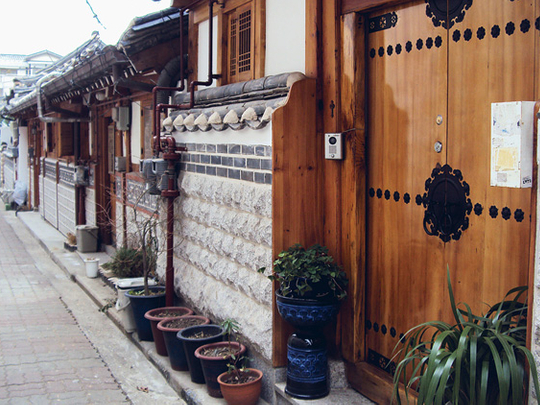
He is known as the feisty foreigner, the outsider waging a one-man fight for "the district where beauty gathers". David Kilburn remembers the first time he wandered Kahoi Dong, a hilly enclave in the heart of Seoul where clusters of traditional buildings known as hanok houses dot winding, narrow streets.
It was 22 years ago but British-born Kilburn can't forget the serenity he felt when he set foot inside one of the historic one-storey homes. It was like stepping back in time, to a quainter Seoul of a century ago.
He marvelled at the aged pine ceiling beams, the graceful curve of the black-tiled roof, the high walls that encircled the courtyard like a cocoon and the wooden doorway that seemed to protect inhabitants from the sterile high-rise apartments that loomed in the near distance. "It was a place of magical beauty," Kilburn said.
A former journalist, Kilburn was in Seoul to cover the 1988 Olympics but fell so much in love with the traditional architecture that he decided to stay. He and his Korean wife, Jade, soon bought a hanok house. But life there has been anything but serene.
For six years, Kilburn has been battling city officials over what he calls the systematic destruction of hanok homes in the area. Despite the creation of a preservation zone there, hundreds of hanoks have been demolished by developers and speculators who use loopholes to cash in on rising land values, he says.
The battle has shaped the 67-year-old tea merchant into an unlikely activist: a foreigner who insists that South Korea is not doing enough to halt the demise of its own heritage.
City officials acknowledge that not all preservation efforts have worked. "We're trying to preserve the hanoks," said Han Hyo-dong, director of the city's Hanok Culture Division. "But we have no legal power. We're trying to enact laws to enforce our protection efforts."
But that is not enough for Kilburn, who, in 2005, launched a website to chronicle demolitions in the protection zone, where he says the number of hanoks has fallen to less than 900 from about 1,600 in 1985.
He says he has sued in court and badgered police and city officials, including President Lee Myung-bak when he was mayor of Seoul, from 2002 to 2006. Armed with a camera, Kilburn documents the demolitions, inspiring a new wave of activism among South Koreans. Many have contacted city officials to express their displeasure over the destruction of the hanoks.
Using a map posted on Kilburn's website www.kahoidong.com, others drop by Kilburn's hanok unannounced, saying they want to go on camera to protest the teardowns. So Kilburn gets his video camera out and tapes them talking about the homes they remember from their childhood and how they should be loved and not bulldozed. Kilburn has collected scores of the video statements on his website.
Not everyone is enthusiastic, though. Although many city officials publicly welcome Kilburn's interest in the hanoks, many dismiss him as a pest. In 2006, the tensions over his protests turned physical.
While videotaping an illegal demolition, Kilburn says, he was assaulted by a construction architect. But it was Kilburn who was later charged with assault. He left South Korea for two years but returned, prepared to start his fight anew.
The battle started in 2004 when a neighbour rebuilt his hanok, causing damage to Kilburn's home. He soon discovered that many homeowners were using city grants and low-interest loans to demolish traditional houses to make way for more modern structures, adding small flourishes to make them look like original hanoks. Kilburn says the teardowns gave the district "all the authenticity of a film set".
Still, some Seoul residents say it is impractical to insist on preserving the original structures, many of which have fallen into such disrepair that they are porous to winter's rain and cold.
Many older residents say they would gladly trade their hanok for a warm apartment in a modern high-rise. Others don't see the wisdom of slavishly restoring homes that were built relatively recently — in the 1920s and the 1930s — not centuries ago.
Such attitudes prevail in other nations as well. Especially in Asia, which is experiencing an unprecedented building boom, cities have begun to erase their pasts. Beijing is tearing down traditional hutongs, or alleyways, that have stood for centuries.
Bulldozers have also been busy in Hong Kong. But Kilburn remains steadfast. "In every country, there are issues about what should be preserved and what should be discarded. Every country tends to preserve its palaces, castles and stately homes," Kilburn writes. But the traditional homes of common people also deserve care, he says.
His thoughts seems to be spreading. Kilburn was recently approached by several college students who wanted to join the preservation cause. "David told me that Korean culture is not just for Korea but for the world," Haam Ye-rim said. "If we don't appreciate hanok houses, who will?"












